
 |
|
|
#31 |
|
Member
Join Date: Dec 2004
Location: What is still UK
Posts: 5,807
|
Very scary man, with a white van? please dont hurt me
 
|
|
|

|
|
|
#32 |
|
(deceased)
Join Date: Dec 2004
Location: East Coast USA
Posts: 3,191
|
graeme gt
I was getting a stiff neck so here you go. Btw Nice club   Lew |
|
|

|
|
|
#33 |
|
Member
Join Date: Dec 2004
Location: NC, U.S.A.
Posts: 2,100
|
Wow!
 That is an incredible club! Very similar to the one from the movie that started this conversation. Forgive me, for I am a novice in this area of collecting, but are these made from the root bulb of the tree? The reason I ask is that I understand that some tribal people did this (as did native Americans, who would use rhododendren root). It looks like this last one might have had root tendrils or something, judging from its surface. Going out on a long limb here... That is an incredible club! Very similar to the one from the movie that started this conversation. Forgive me, for I am a novice in this area of collecting, but are these made from the root bulb of the tree? The reason I ask is that I understand that some tribal people did this (as did native Americans, who would use rhododendren root). It looks like this last one might have had root tendrils or something, judging from its surface. Going out on a long limb here... 
|
|
|

|
|
|
#34 |
|
Member
Join Date: Sep 2008
Posts: 97
|
Hi its made from a root couldnt tell you which one tho .
|
|
|

|
|
|
#35 |
|
(deceased)
Join Date: Dec 2004
Location: OKLAHOMA, USA
Posts: 3,138
|
TRIBAL PEOPLE OFTEN SELECTED THEIR MATERIALS FOR TOOLS AND WEAPONS FROM WHATEVER NATURE PROVIEDED THAT WORKED BEST FOR THE PURPOSE. MANY PLANTS ARE HARD AND DENSE ENOUGH TO MAKE A GOOD NATURAL CLUB, A PLANT WITH A GOOD HEAVY ROOT BALL WAS EASILY SHAPED. SOMETIMES THE SHAPEING BEGAN WHEN THE PLANT WAS STILL GROWING, A PLANT COULD BE BENT TO FORCE IT TO GROW IN THE SHAPE OF THE DESIRED WEAPON OR TOOL. A BAND OF STRONG MATERIAL COULD BE PLACED TIGHTLY AROUND THE TRUNK NEAR THE GROUND WHICH CAUSED THE TRUNK TO BULGE OUT AND BECOME LARGER IN DIAMETER ABOVE THE RESTRICTION.
SOMETIMES THE TRUNK WAS ACTUALLY SPLIT AND A STONE INSERTED WHICH THE PLANT WOULD GROW AND HEAL AROUND AND THEN ALL NEED BE DONE WAS CUT THE DESIRED PIECE OUT FOR A STONE HEADED CLUB OR TOOL. SOME OF THE SHAPEING WAS ALSO DONE PURLY FOR THE ARTISTIC APPEAL AS LINES AND RIDGES AND TWISTED CORKSCREW TYPE SHAFTS COULD ALSO BE MADE USING VARIOUS LIVING SHAPEING TECKNIQUES. QUITE A NICE BASHER YOU HAVE THERE IT IS A BEAUT!! THESE BURLS USUALLY HAVE VERY INTERESTING AND OFTEN BEAUTIFUL GRAIN PATTERNS KIND OF LIKE MOTHER NATURES ORGANIC WOODEN VERSION OF WOOTZ  THIS WOOTZ IS APPRECIATED BY ALL WOODWORKERS AS WELL AS THOSE WHO LOVE A NICE BRIAR PIPE. THIS WOOTZ IS APPRECIATED BY ALL WOODWORKERS AS WELL AS THOSE WHO LOVE A NICE BRIAR PIPE.
|
|
|

|
|
|
#36 |
|
Member
Join Date: Dec 2004
Location: NC, U.S.A.
Posts: 2,100
|
Excellent information on the 'harvesting' of clubs, Barry. I knew I wasn't going crazy when I had heard of ground roots. I had never heard of the insertion of stones to allow the plant to grow over it. Pretty amazing! Now I'm beginning to want to collect clubs again! (sold my Soloman Islands piece awhile back). Great thread!
|
|
|

|
|
|
#37 |
|
Member
Join Date: Dec 2004
Posts: 1,247
|
Hi All,
I agree that root burls (that's the proper term) can make great club heads. In fact, I've got one sitting in a garage for that some-day project. That said, not every club head is a burl, and I'll tell you how to tell the difference in a second. Many shillelaghs actually aren't made from a root burl. Rather, the crafter starts with a tree or shrub (traditionally blackthorn, a type of plum). He selects a trunk or major branch that has many straight, smaller shoots coming off of it. He then cuts the trunk into short sections around the branch, so that the straight shoot becomes the handle of the shillelagh, and the trunk becomes the head. He then carves the head into shape. The way you tell how it's made is to look at the grain on the head. Burls typically have a confused grain. It looks like random damascus. Trunks have the concentric, circular grain. As an example of a head carved from a trunk, here's a knobkerrie that Louie posted earlier Anyway, I admire shillelaghs, and perhaps I'll get one someday. My only problem with them is that they're supposed to be less obvious weapons (the farmer's evening walking stick, really). These days, no one carries a walking stick for walking, so I'd be less obvious if I was walking with a golf club than if I was carrying me blackthorn. If less classy. Best, F |
|
|

|
|
|
#38 |
|
Member
Join Date: Jan 2006
Location: Kent
Posts: 2,653
|
I have been saving this project for a while. After having to remove several branches from my Ash tree .....I cut and saved several branches to make either axe hafts or a club / knobkerrie. Left to season for 3 years it is now ready to 'work'. I like the idea of 'experimental' archeology.....inspired by this thread and the sunshine (yes, we do get the sun in Britain ....sometimes
 ) I decided to make a 'start' ....determined to use hand tools ...I have used the hand axe to cut and 'rough shape' the club. Its a little big at the moment ....feels great as a 'two hander'....but want to gradually improve / remove wood so as to get the correct balance etc. ) I decided to make a 'start' ....determined to use hand tools ...I have used the hand axe to cut and 'rough shape' the club. Its a little big at the moment ....feels great as a 'two hander'....but want to gradually improve / remove wood so as to get the correct balance etc.If anyone is interested I will post as work continues....I am hoping that I will acquire an insight in the design, manufacture and use of such weapons. Regards David PS ....As to size...each paving slab is 18 inches (46cms) square |
|
|

|
|
|
#39 |
|
Member
Join Date: Jan 2008
Posts: 1,430
|
Great stuff David. Looking forward to seeing the finished product. You may be interested in this description of the making of a Masai knobkerrie
Regards |
|
|

|
|
|
#40 |
|
Member
Join Date: Jan 2006
Location: Kent
Posts: 2,653
|
Thanks Colin
 , ,excellent stuff, much appreciated........ would you mind posting the next page.....my traditional Same is 'scabbard-less' ....and just as I got 'distracted' by the description of making the scabbard ....I realised it was incomplete  ( (  ) Thank you ) Thank youKind Regards David |
|
|

|
|
|
#41 |
|
Member
Join Date: Jan 2008
Posts: 1,430
|
Here is the next page David.
Best regards Colin |
|
|

|
|
|
#42 |
|
Member
Join Date: Jan 2006
Location: Kent
Posts: 2,653
|
Thank you very much Colin
 Regards David |
|
|

|
|
|
#43 |
|
Member
Join Date: Dec 2004
Posts: 1,247
|
Neat stuff, Colin and David. What is the title of that book.
Best, F |
|
|

|
|
|
#44 |
|
Member
Join Date: Jan 2008
Posts: 1,430
|
The name of the book is "Barefoot over the Serengeti" by David Read
|
|
|

|
|
|
#45 |
|
Member
Join Date: Dec 2004
Location: What is still UK
Posts: 5,807
|
Here is another East African example.
|
|
|

|
|
|
#46 |
|
Member
Join Date: Jan 2006
Location: Kent
Posts: 2,653
|
Hi
had some time to continue the 'club'...not quite finished, but I have learnt alot. Some observations I have noted.... the branch dictates the size and shape of the finished head/knob due to the structural grain pattern of the wood. If you ignore the grain you would seriously weaken the finished article. The initial shaping is relatively easy and quick ....so if a club/knobkerrie was needed in a 'hurry' ...a reasonably functional piece could be made. However, the 'fine' tuning and a good finish takes some time. I worked on the premise that the head should be worked first ....as this would determine the length and thickness of the handle (the handle was, at first, deliberately left too long / too thick ..as it is relatively easy to cut shorter and thin it, as required to give balance/useable length) Using heat I was able to scorch / draw natural oils to the surface which improves the hardness. Treatment not done to the handle ...as a natural flex would probably absorb the impact 'blow' better. I have quickly tested this on my very large anvil....gradually increasing the power of the impact and assessing the damage to the club head each time..two handed with a lot of force ....NO DAMAGE..... I am stunned by how lethal a blow to the head this club could deliver. Admittedly this club is larger than the usual knobkerrie ( forced by nature ..size determined due to the grain of the wood). Handle is at present too long....great for two handed 'operation' but needs to be shortened for effective one handed use. The dynamics of 'balance' also raise a few questions..... if the handle end was weighted ....the 'head size' could be increased and still be 'controllable' and would 'pack more of a punch'. If that weight was a metal 'spiked pommel' you would add another dimension to its use in close quarter fighting (much like a sword pommel sometimes used to strike an opponent during the melee) Are there any examples of clubs/knobkerries with this addition ? Regards David |
|
|

|
|
|
#47 |
|
Member
Join Date: Jan 2008
Posts: 1,430
|
Hi David
Interesting to see how your club is coming along. As far as I know, the concept of a weapon with a striking surface at one end and another striking or stabbing function at the other end, has not really developed and shown to be practical. Given the tens of thousand of years mankind has been inventing weapons, I suppose this means the concept has been tried and discarded. The only possible examples I can think of are the Indian double-bladed dagger "haladie" and a rifle with a bayonet - the stock could be used also as a club "in extremis", although there must be others... Regards. |
|
|

|
|
|
#48 | |
|
Member
Join Date: Jan 2006
Location: Kent
Posts: 2,653
|
Quote:
thanks for the reply. A few years ago I saw an 'offset' knobkerrie with a spike set in the handle end. The short spike was around 3" long (exposed) from the leather covered 'handle'. Never got to handle it...and only seen from a distance. I assumed that a short spear butt had been added to the knobkerrie....whether originally or added later. I have heard of situations whereby weapons...African or otherwise were altered / changed (seemed more prevalent in the Victorian era ....perhaps 'their' love of 'fantasy' and the 'exotic' , fuelled these conversions  ) )My main question was the idea of counter-balancing the 'head' of the knobkerrie with a metal 'pommel'. Helping to balance a 'larger' head on a longer shaft would possibly make the 'function' more efficient. ie one aimed strike would be sufficent to dispatch your foe as the weight, length (increased speed / leverage) would generate much more 'impact energy'  Longer shafted knobkerries have a smaller head ....and some accounts from the Zulu Wars suggest that a number of strikes were required ....unless an accurate strike to the head had occurred. Longer shafted knobkerries have a smaller head ....and some accounts from the Zulu Wars suggest that a number of strikes were required ....unless an accurate strike to the head had occurred.Perhaps, the use of the knobkerrie in battle does not require improvements in its design. The Zulu are reported as carrying a shield, spear and knobkerrie....perhaps the techniques / tactics used, meant that design of the knobkerrie was more than adequate. Kind Regards David |
|
|
|

|
|
|
#49 |
|
Member
Join Date: Jan 2008
Posts: 1,430
|
I've just had a look at the Pitt-Rivers Museum "Arms & Armour Virtual Gallery" website, and it has a picture of a South American club "Macana", that features a counter-weight at the butt end of the club, in the manner you were thinking of.
Perhaps you could experiment with the club you are making by attaching a temporary weight to the handle end ? Of course, clubs/knobkerries were used in different ways - the Masai threw theirs at the enemy before a massed spear charge, but the Zulus tended to hold on to their clubs for hand to hand combat. Also some clubs would be for purely display/element of costume. The Zulus also had a knobkerrie with an enormous head that was used for the execution of condemned individuals. There is also a huge range of clubs to be found in the Pacific and Australasia. Some of the Fiji clubs would require warriors of great strength to wield them. Best regards Colin |
|
|

|
|
|
#50 |
|
Member
Join Date: Dec 2004
Location: What is still UK
Posts: 5,807
|
There is this type of spiked club from South Sudan. Also one similar with a leaf shaped spear blade instead of the spike. They are short clubs so even with a big ball I think easily used in one hand and much like double pointed fighting sticks. pic from "C, Spring. African arms and armour"
|
|
|

|
|
|
#51 |
|
Member
Join Date: Dec 2004
Posts: 1,247
|
Hi David,
Neat club. One technique I ran across, but haven't tried yet, is using an iron bar to systematically harden the surface of a quarterstaff. Perhaps you can do something similar with the club head and the anvil... As for a spike on the butt end, as we know, it's pretty common on knives and some swords, and there are wooden stabbing knives (single and double ended). I suspect that the problem with putting a spike on the end of a long club is that the centrifugal force of swinging the handle will tend to pull your hand down over the spike and off the end. Ideally, you'd want the shaft to flare before narrowing down to a spike, so that you could grip the club and swing full force, without your hands slipping. That said, there is something to be said for having a fighting point on the back end, because it would be good for close-quarter fighting. As for short clubs, the Mojave tribe had short clubs with spikes on the handle, so I'm not surprised that the Sudanese were doing something similar. Fun stuff! F |
|
|

|
|
|
#52 |
|
Member
Join Date: Jun 2007
Location: Detroit (New Mayapan)
Posts: 96
|
Inspired by Katana's work, I felt compelled to make one just for myself. So, I took a good piece of maple heartwood and went for an antiqued and distressed look.
Full shot. It's about 30" overall: 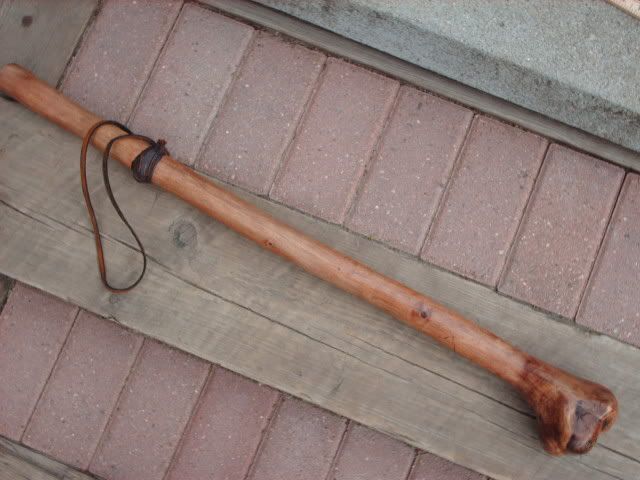 Part of the head is real burlwood: 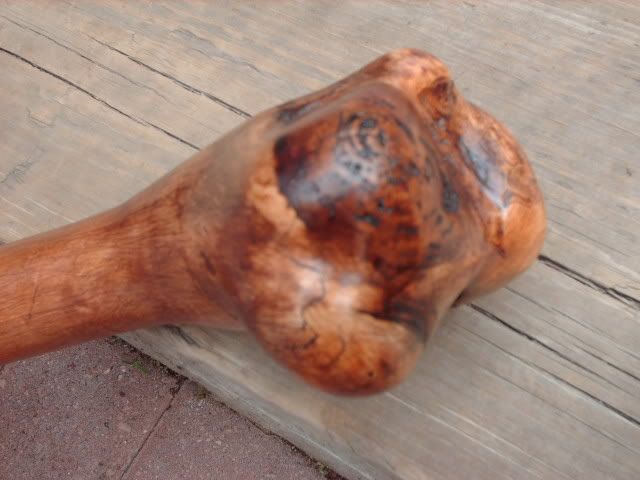 In hand: 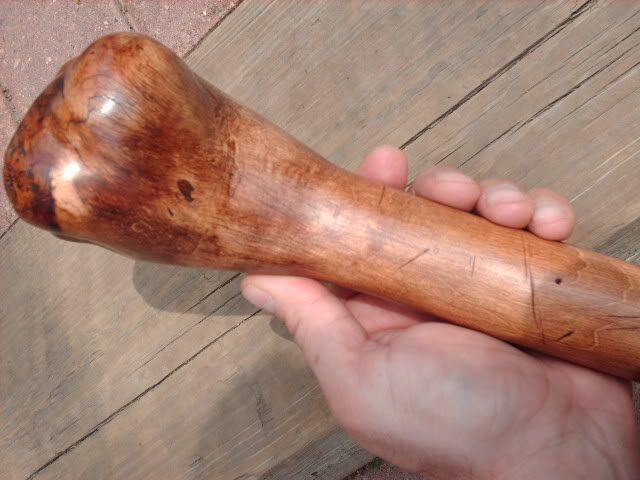 Some antiquing/distressing. You can see the scratches filled in with patination, but there are also some dents which I made but I can't get in the photo: 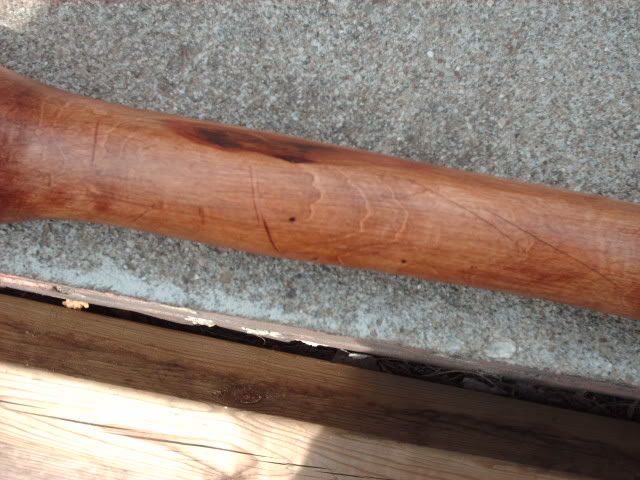 I stretched wet calfskin and tied it into a knot to secure the rawhide lanyard, then antiqued all of it: 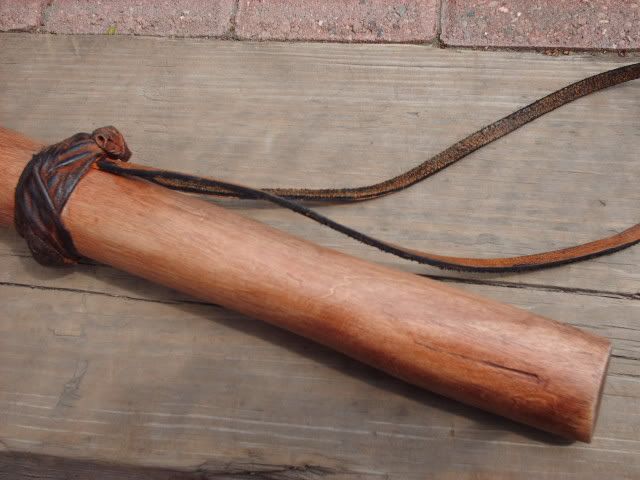 Full shot against my white birch: 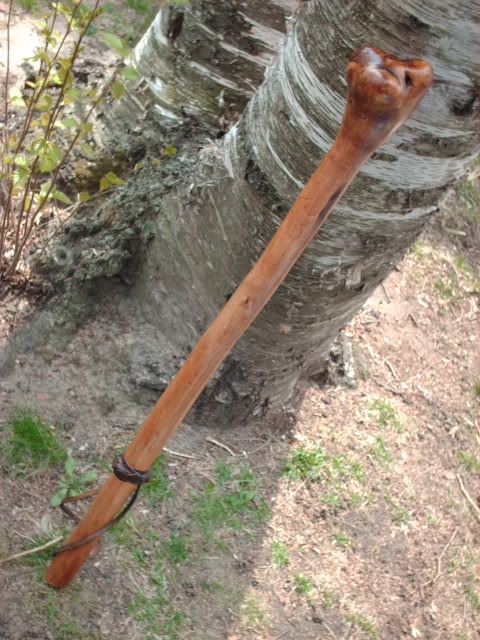 Closer shot: 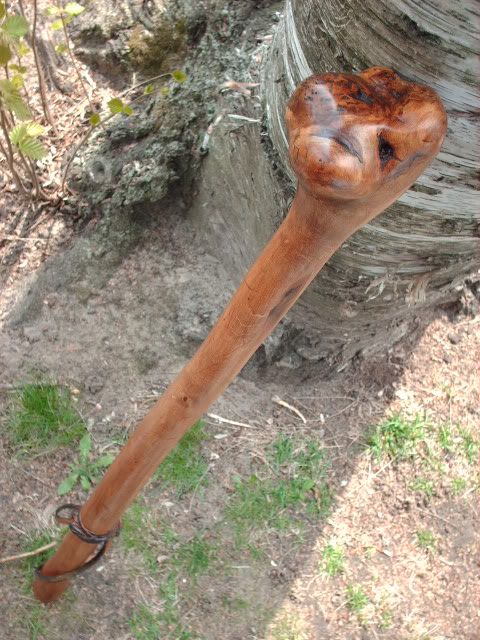 I used all of my antiquing tricks on this. So, here's a question for you antique weapons experts: how authentic does the antiquing look? If I were unscrupulous enough to put this on ebay and say it was 100 years old (not that I plan on doing so!), would it pass? |
|
|

|
|
|
#53 |
|
Member
Join Date: Dec 2004
Posts: 1,247
|
Hi Queequeg,
Nice work, and a nice club. It's actually hard to answer your question, because it's already in context as a modern club, and that biases the way I look at it. That said, it doesn't look one hundred years old to me, but you could probably pass it off as such if you really wanted. F |
|
|

|
|
|
#54 |
|
Member
Join Date: Jun 2007
Location: Detroit (New Mayapan)
Posts: 96
|
Thanks, Fearn.
I'm finding out that making something look rustic and old is actually fairly difficult- it's just too easy to overdo or under-do it. Also during distressing you have to purposely achieve a randomness about it or your process will fall into a pattern which a discerning eye will easily see. |
|
|

|
|
|
#55 |
|
Member
Join Date: Mar 2006
Location: Room 101, Glos. UK
Posts: 4,184
|
holy resurrection,batman!
found this looking for something else  thought it needed a bump. thought it needed a bump.adding my 24in. shilleghlegh below for interest. below that is a 'new' (to me) 19c vinewood one i just recv'd, 648 grams, 91 cm. brass ferrule on the ground end. rather unusual deep 3d wood 'grain'. very smooth polish. up the chimney & buttered? |
|
|

|
|
|
#56 |
|
Member
Join Date: Nov 2012
Location: Halstenbek, Germany
Posts: 203
|
Here is a piece from the North German Younger Neolithics found 2003 in the bog Bernumerfehn near the city of Aurich in Lower-Saxony, Germany. The piece was 14C dated to ca 2700 B.C. Made of yew wood, length of 685 mm, diameter of the head 85, length of the head 97 mm. A really beautyful piece which shows a contemporary repaired handle which started to split from the end. It was repaired with a strip of leather.
|
|
|

|
|
|
#57 |
|
Member
Join Date: Mar 2006
Location: Room 101, Glos. UK
Posts: 4,184
|
i'm having a half sized galloglass sparth axe made with a yew haft. it's going to be a good looker.
|
|
|

|
 |
|
|